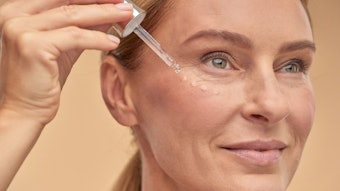
Papers published over the past two decades describing how changes in elastin are associated with skin photoaging are both puzzling and varying. Some point toward the activation of proteolytic enzymes that cleave elastin in a randomized manner, leading to decreasing structural integrity and inelasticity; others point to an accumulation of the secreted soluble precursor protein tropoelastin, in a condition termed solar elastosis. Though there is consensus on the importance of elastin in skin health and appearance, no systematic method has elucidated how the clinical manifestations of elastin in the dermal layer are correlated to its structure-function attributes.
In this paper, the authors review key findings in the published research and highlight measurable gaps, which potentially could marry these two divergent analyses for a complete picture. This prospective knowledge may contribute to understanding changes in elastin structure and, hence, function and implications for aged skin, elasticity and disease, with potential for future skin care targets. Elastin plays an important biological role in skin’s structural and mechanical integrity, thus the development of unbiased targeted and quantitative studies to investigate the production and integrity of elastin, its soluble precursor tropoelastin and its variants (such as through structural and functional proteomics) is warranted.
Elastin Isoforms and Skin Metabolism
Elastin is a cross-linked network of monomeric polypeptides rich in insoluble amino acids, including glycine and proline. This network depends on hydrated milieus, which form unstructured hydrophobic regions bound by cross-links between lysine residues.1 In the dermal skin layer, elastin forms, together with collagen, the extracellular matrix (ECM), which is the skin’s physical and mechanical foundation. Similar networks are present in other connective tissues (notably in the lungs and arteries), allowing tissues to return to their original rest-state shape after extending or tightening. The ECM, therefore, plays a key role in skin’s structural integrity and biomechanics, permitting for persistent flexibility and repeated stretch and relaxation cycles. Elastin integrity is greatly reduced with aging, injury and sun exposure. Presumably, this can be associated with persistent catabolism by proteolytic enzymes, which break down its three-dimensional structure; consequently, skin gradually loses elasticity.
The elastin precursor tropoelastin is soluble, and exists in multiple transcript variants to encode for different isoforms. Due to the many possible isoforms, the same elastin gene translates to diversity within the elastin proteome, generating a family of structurally related proteins that vary in their mechanics, orientation, responsiveness to stimuli and, hence, their functionality. In fact, the elastin gene, when translated to mRNA, can be expressed in a variety of patterns that differ in their arrangement, interaction with ligands, stability to proteolytic degradation and functionality at the protein level. Stated another way, functions in the body are not carried out only by nucleus entities (i.e., DNA or mRNA) but by proteins. Nucleic acids are just codes. In fact, 50% of the nucleus material is protein, which controls functionality at the nucleus level. Therefore, measurements of levels of elastin and/or tropoelastin gene expression at the mRNA level can provide only partial information about biological activities
Moreover, it is known that the primary transcript of elastin undergoes extensive splicing during gene expression, resulting in a single gene coding for multiple proteins that, therefore, cannot be detected at the DNA and/or mRNA levels. This process leads to the translation of multiple heterogeneous protein isoforms; for humans, 44 have been annotated in the peptide atlas proteomic database.2 Due to the complexity of these processes, quantitative gene expression alone, if not supported by or replaced with proteomic analysis, may lead to misinterpretation of the biochemical effects, which will be explained in more detail later in this paper.
Effects of Solar Radiation
Actinic or solar elastosis is the accumulation of abnormal elastin, particularly in the upper reticular dermis. This increase in atypical protein levels is thought to be associated with cumulative effects of prolonged and excessive sun exposure. The clinical manifestation of solar elastosis appears as thickened, dry and wrinkled skin. In 2009, Chen et al.3 found that ultraviolet (UV) irradiation and heat increased the levels of elastin transcript containing a specific exon—i.e., a partial nucleotide sequence encoded by a gene. This exon encoded for an elastin isoform in the epidermis of human skin in vivo and in cultured human keratinocytes. In addition, they found that the elastin transcript-containing exon was upregulated in photoaged forearm skin, compared with intrinsically aged and less exposed buttock skin in the same elderly age individuals. These findings suggest that the production of the elastin isoform containing this specific exon is increased by UV exposure and heat in the human skin in vivo, and, therefore, may play an important role in the development of solar elastosis and photoaged human skin.
A study by Seo et al.4 demonstrated that UV irradiation induced tropoelastin mRNA expression in keratinocytes of human skin in vivo, as well as in cultured human keratinocytes—as assessed in situ by hybridization and reverse transcriptase polymerase chain reaction (RT-PCR). Northern blot analysis also showed increased tropoelastin mRNA levels in the sun-exposed forearm skin of elderly individuals, compared with sun-protected upper-inner arm skin of the same individuals. In addition, in situ hybridization demonstrated that tropoelastin mRNA expression in photoaged skin was higher in both keratinocytes and fibroblasts, compared with sun-protected, upper-inner arm skin. The researchers concluded that keratinocytes are another source of tropoelastin production after acute and chronic UV irradiation in human skin in vivo.
In other studies, Schwartz et al.5 and Kim et al.6 demonstrated that in sun-exposed skin, elastin accumulated in amounts two to six times that of levels found in young skin. Also, the amount of tropoelastin in UV-treated fibroblasts was elevated to almost twice the amount of non-treated cultures; however, unlike previous studies, this effect was not associated with increases in cell proliferation or tropoelastin mRNA levels. This accumulation was thought to be associated with post transcriptional modifications at the protein levels, although it is possible that the mRNA analysis did not recognize all isoforms. In relation, a study by Langton et al.7 measuring both elastin and tropoelastin levels in photodamaged skin found that the accumulation of both the protein and its precursor led to the generation of amorphous fibers and, hence, a loss in elastic fiber integrity.
Adding to the perplexity of the “enzymatic degradation (i.e., potential depletion) vs. solar elastosis (i.e., accumulation)” debate for elastin, the scientific skin care community has established a theory linking oxidative stress, inflammation and the enhanced activation of matrix metalloproteinases (MMPs) in skin aging to the clinical manifestation of wrinkling.8 While some data was established at the gene expression level, no studies were conducted on potential changes at the tropoelastin isoform level. Also, no direct measurements of elastin at its structure-function level were made.
This MMP evidence shifts the explanation for elastin degradation in photoaged skin back toward its catabolism by degradation enzymes.9 Elastin and ECM components are catabolized by the over-activation of MMP enzymes;9 specifically, the catabolic enzyme MMP-1 or collagenase-1, along with MMP-2 and MMP-9, i.e., gelatinases A and B, respectively. In addition, reactive oxygen species (ROS) generated in the skin upon exposure to solar radiation induce specific MMP activities.10
Gene Expression vs. Functional Proteomics
As stated above, due to the complexity of these processes, gene expression that is not superimposed with proteomic analysis may lead to the misinterpretation of biochemical effects. The proteome is the entire complement of proteins, including modifications made to particular sets of proteins, produced by an organism or system. Proteins are a vital part of the living organism, controlling metabolic paths of cells. They serve as receptors, transporters, mediators, enzymes and network components of extracellular matrix domains. Analogous to the field of gene expression for mRNA analysis, the field of proteomics surveys the presence of proteins. However, unlike gene expression, proteomics also can assess structure, splice variants, post-translational modifications and interactions with compounds, substrates and other proteins, affording a much deeper view of the functional relevancy of phenotypic characterizations. Proteomic analysis, therefore, provides an alternative to gene expression that can answer some of the previously described conflicting data in the literature.
In recent years, gene expression analysis has been used to study the reactivity of certain treatments to skin. While this approach provides some mechanistic insights for cells that deviate from normal, it only indirectly infers cellular biochemical cascades, as it is now generally acknowledged that mRNA regulation is not always correlated to protein regulation and function. Therefore, as stated previously, unless gene expression is superimposed with proteomics, clinically relevant features of the phenotype may be misrepresented. In fact, the amount of protein produced for a given amount of mRNA depends on the gene from which it is transcribed and on the current physiological state of the cell.
Though the cascading events that further control the translation of mRNA to protein and its activation are highly complicated and beyond the scope of this review, it must be noted that the goal of proteomics is to compare and identify which proteins are deviated from homeostasis and their amounts, structures and interactions with other regulating constituents. While such comprehensive assessments are rarely achieved in proteomics, the field has advanced many new methodologies—for example, to efficiently profile subsets of proteomes and to target functional or structural surveys to allow faster, more cost-effective and more accurate analysis. The selection of such methodologies, of course, depends on the hypotheses posed and biological outcomes to be monitored. So if gene expression data is available, that could be a good place to start.
Great progress has been made in uncovering clinically informative gene expression patterns that suggest pathway associations with diseases or compound-induced modulation. However, two key challenges remain. The primary one is establishing a correlation between the prospective gene markers and their corresponding protein products, especially which subsets are the most relevant to clinical features of the skin phenotype. A second challenge is to distill this vastly informative subset of genes to assayable biomarkers that can be readily measured from biological tissues. A variety of tools and techniques support such targeted proteomic efforts. Figure 1 outlines paths extending beyond gene expression analysis, which demonstrate benefits for establishing knowledge more accurately correlated to clinical manifestations.
Missing Links of Elastin Integrity
The Schwartz et al.5 study, referenced previously, delved into the mechanisms associated with elevations in elastin and its precursor upon exposure to UV radiation. Utilizing a slot blot hybridization technique, the group determined that the accumulation of radiolabeled tropoelastin in UV-irradiated cell culture was purely at the post-transcription protein level—not at the DNA or mRNA level. The investigation of base substitutions of irradiated mRNA pointed to alterations only at non-translated mRNA domains. On the other hand, no base substitutions were detected in coding domains of tropoelastin. This means that the effect of UV radiation could only be associated with cascades post tropoelastin formation.
UV exposure can potentially lead to changes in tropoelastin isoform distribution, shifting the variations in structural diversity from normal, which can affect elastin functionality. Such isoform redistribution can lead to deviations in the enzymatic recognition of the insoluble elastin protein as MMP substrate. This may result in an abnormal and potentially less functional elastin profile.
The abnormal elastin may, therefore, exhibit higher affinity to proteases, resulting in a feedback protection mechanism that leads to the accumulation of additional abnormal elastin and, as a compensatory mechanism, a higher expression of tropoelastin. Such investigation can be conducted utilizing functional proteomics technologies on a kinetic time-scale that may answer questions such as: What is the correlation between exposure to solar radiation and changes at the protein levels, structures and functionality? What strategies should be investigated to promote maintaining elastin at its functional level? What kinetics and factors are affecting the translation of tropoelastin to a functional protein? (see Figure 2). In fact, the discrepancy between the two seemingly different theories of enzymatic degradation and solar elastosis may be explained on a kinetic time scale, where the post-transcriptional effects on tropoelastin detected a short time after UV exposure are compensated for by over-expression at the mRNA levels when a more chronic exposure regimen is utilized.
Proteomics Proposition
As noted, the attempt to imply a dichotomy in the differentiation between young and aged skin by merely comparing quantities of elastin and/or its precursor may be misleading, especially since the ECM is a dynamic structure in which the fiber network is reassembled constantly and is affected both biologically and chemically. In an environment where anabolic and catabolic processes are always occurring, structure-function relationships are of key importance.
Figure 3 illustrates the many possible anabolic and catabolic influences on elastin structure. Note that for the right side panels, the methods for these measurements are well-developed; on the left, such methods for anabolic systems are poorly developed.
With advancements in proteomic enrichment, separations and LC-MS analysis, new methods to support tropoelastin measurements are achievable. This may finally help to answer many important biological questions of the behavior of elastin on a proteome scale.
Author’s note: Dr. Nava Dayan LLC and Biotech Support Group LLC (BSG) have formed a collaborative initiative combining skin science and research, with wet-end experimental observation and bioinformatic interpretation. For more information, e-mail [email protected].
References
- SM Mithieux and AS Weiss, Elastin, Adv Protein Chem 70 437-61 (2005)
- www.peptideatlas.org (Accessed Jul 21, 2014)
- Z Chen et al, Modulation of elastin exon 26A mRNA and protein expression in human skin in vivo, Exp Dermatol 18(4) 378-86 (Apr 2009)
- JY Seo et al, Ultraviolet radiation increases tropoelastin mRNA expression in the epidermis of human skin in vivo, J Invest Dermatol 116(6) 915-9 (Jun 2001)
- E Schwartz, E Feinberg, M Lebwohl, T Mariani and CD Boyd, Ultraviolet radiation increases tropoelastin accumulation by post-transcriptional mechanism in dermal fibroblasts, J Invest Dermatol 105 65-69 (1995)
- HH Kim et al, Photoprotective and anti-skin-aging effects of eicosapentaenoic acid in human skin in vivo, J Lipid Res 47 921–930 (2006)
- AK Langton, MJ Sherratt, CEM Griffiths and REB Watson, A new wrinkle on old skin: The role of elastic fibers in skin aging, Intl J Cos Sci 1–10 (2010)
- R Thakur, P Batheja, D Kaushik and B Michniak-Kohn, Structural and biochemical changes in aging skin and their impact on skin permeability barrier, in N Dayan, ed, Skin Aging Handbook, Elsevier, NY (2008)
- B Gogly, FC Ferré, H Chérifi, A Naveau and BP Fournier, Inhibition of elastin and collagen networks degradation in human skin by gingival fibroblast. In vitro, ex vivo and in vivo studies, J Cos, Derm Sci and Apps 1, 4–14 (2011)
- A Svobodova, S Walterova and J Vostalova, Ultraviolet light induced alteration to the skin, Biomed Pap Med Fac, Univ Palacky Olomouc Czech Repub 150(1) 25–38 (2006)










